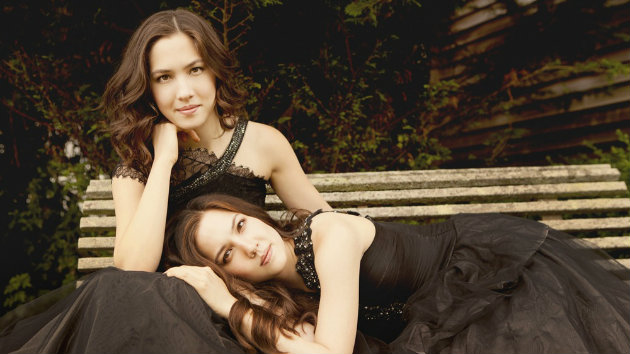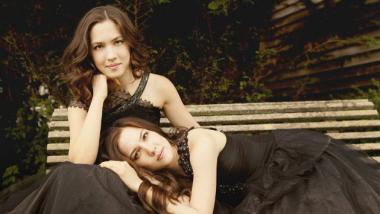
The Santa Rosa Symphony season opener was a double bill in more ways than two. It featured two piano concertos and two pianos played by two identical twins. Pianist sisters Christina and Michelle Naughton are virtually indistinguishable from afar, and they also wore nearly the same dresses. They were even more indistinguishable in their playing and technique. They and the orchestra came together for an evening of superior music-making on Sunday at Sonoma State’s Green Music Center.
The Naughton’s synchronicity is the essential quality for a piano duo. Instead of contending with a pair of divergent interpretations, conductor Bruno Ferrandis and the orchestra enjoyed the luxury of playing with one super-pianist with four arms and 20 fingers.
The unanimity was apparent from the opening measures of Mozart’s Concerto For Two Pianos, K. 365. Playing gracefully together, they traded emotionally matched lines back and forth, with neither trying to outdo the other. The orchestra projected a warm sound, creating an expansive backdrop for the Naughtons’ remarkable artistry. Each movement was sharply etched, with rock-solid playing.
The Mozart concerto, suffused with incandescent melodies, is a wonderful piece, and it received a wonderful performance. The orchestra projected a warm sound, creating an expansive backdrop for the Naughtons’ remarkable artistry. Each movement was sharply etched, with rock-solid playing. The only flaw — and it was a minor one — was the Naughtons’ restricted dynamic range in the last movement. The soft passages could have been softer and the loud much louder.
In Francis Poulenc’s Concerto For Two Pianos, one of the sisters’ calling cards, their playing was exemplary. This rarely heard concerto is a model of musical invention and vivacity. It begins fervently, with rapid call and response between the two pianos, and between the pianos and orchestra. The interchange was playful and rollicking.
The complexity of the first movement was balanced by the simplicity of the second. The Naughtons played an ethereal, looping duet that sounded almost minimalist in its incessant repetitions.
The final movement began with a piano solo that sounded straight out of Mozart. After an orchestral response, the subsequent solo sounded like Beethoven. The next time around, it was Chopin. This constant shift of musical personalities was matched by a stunning variety of sounds and textures from the orchestra.
The two concertos were bracketed by a concert-opening new work and a closing favorite. The new one came from the pen of Mohammed Fairouz, a widely performed, 29-year-old, Arab-American composer who has already produced an impressive body of work. His style is accessible, distinctive, and inventive — with the notable exception of the work commissioned and premiered by the Santa Rosa Symphony, Pax Universalis.
The new piece begins promisingly enough, with strings syncopating against a resonant and well-struck wood block, which tocks like a metronome. The melody sounds faintly Mexican, in a traditionally cheerful, dance-like vein. After a few more bars, it begins to sound like a John Williams movie score. The melody is traded back and forth between strings, woodwinds and brass without developing into anything else and the music builds to a predictable climax.
If Pax Universalis had been written by somebody less renowned, it could be dismissed out of hand. But because it’s from Fairouz, you wonder if it’s just an aberration.
Another aberration, this one positive, closed the program: Saint-Saens’ Symphony No.3, “Organ.” Most of Saint-Saens’ music has faded from the repertoire, but the “Organ” Symphony is still much performed, and with good reason. Its themes are memorable, its effect, in a good performance, transformative.
All cylinders were firing in the symphony’s well-oiled traversal. The orchestra was responsive to Ferrandis’s baton, the sound was rich and full, the string sections played in ringing unison. The organ, ably played by Charles Rus, transformed the second movement into a church service and began the last with a tremendous bang.
Perhaps the most impressive aspect was the relentless forward momentum, which began barreling along so rapidly in the third movement that Ferrandis’s baton flew high in the air and landed in the audience. With a replacement in hand, he continued fervently leading the orchestra through the triumphant finale.

